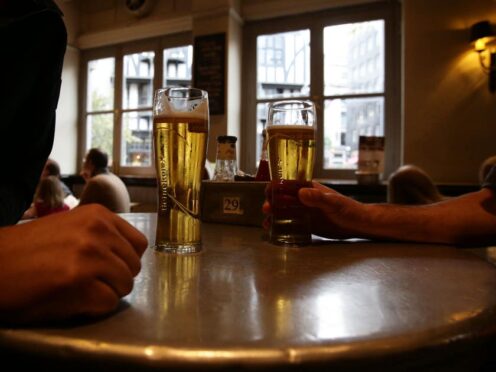
Campaigners have demanded action to tackle Scotland’s continuing “alcohol emergency” as new figures showed the rate of drink-related deaths is still the highest in the UK.
Alcohol Focus Scotland warned that Scotland’s “already overstretched NHS” could now be facing a “ticking timebomb of alcohol-related illness and deaths”.
It spoke out as new data from the Office for National Statistics (ONS) showed alcohol-specific deaths across the UK had reached a record high, with 10,048 people dying in 2022.
While there were 16.6 deaths per 100,000 people across the UK, in Scotland the rate was higher, at 22.9 deaths per 100,000.
Speaking about the situation across the UK, David Mais, a health statistician with the ONS, said: “Alcohol-specific deaths rose sharply with the onset of the pandemic and today’s results show a continuation of that trend, with deaths around a third higher than in 2019.”
There were 1,276 deaths in Scotland in 2022 – with this the highest total since 2008 – with the latest figures showing that 836 men and 440 women died as a result of alcohol.
Deaths among women were up from 361 in 2019 – an increase of almost 22% – while deaths among men were up by nearly 27% over the same period, rising from 659 in 2019.
Alcohol Focus Scotland said overall deaths had seen a “staggering increase of 25%” since 2019.
We've published the latest data on alcohol-specific deaths in the UK registered in 2022.
10,048 deaths (16.6 per 100,000 people) from alcohol-specific causes registered in the UK, the highest number on record.
— Office for National Statistics (ONS) (@ONS) April 22, 2024
The figures were published less than a week after MSPs agreed to increase the minimum unit price (MUP) charged for alcohol in Scotland from its current level of 50p a unit to 65p.
The Scottish Government has said the price rise, which will come into force at the end of September, will help save lives.
Alcohol Focus Scotland chief executive officer Alison Douglas said: “Despite the Scottish Government’s acknowledgement that this is a public health emergency, we are still not seeing an adequate emergency response.”
She said the latest ONS figures “confirm that despite the lifesaving impact of minimum unit pricing (MUP), Scotland remains in the grip of an alcohol emergency”.
Ms Douglas warned: “Changes to drinking patterns during the Covid-19 pandemic have sadly become embedded and represent a ticking timebomb of alcohol-related illness and deaths for our already over-stretched NHS.”
While the rate of alcohol-specific deaths among men reduced slightly in 2022 to 30.9 deaths per 100,000, the rate for women rose to 15.1 per 100,000 – the highest level since 2008.
Ms Douglas said: “Every life lost due to alcohol is a preventable tragedy for individuals, families, friends and communities. It is particularly concerning to note the increase in death rates for women.”
She added that while alcohol deaths were rising “people accessing alcohol treatment in Scotland has declined by 40% over the last ten years”.
She said that “this has to change” as she called for more action from the Scottish Government.
The latest @ONS #Alcohol Specific Deaths Figures for the UK show another record high number of deaths at 10,048.
The data confirms that deaths have risen at a slower rate in Scotland than England, likely due to the protective effective of #MUP.https://t.co/y1Xd8dCXQn pic.twitter.com/m4KdFnFr1w
— Alcohol Focus Scotland (@AlcoholFocus) April 22, 2024
Ms Douglas said: “We must improve treatment and recovery support. But we also have to prevent the health and social harms caused by alcohol in the first place.
“We know what works – making alcohol less affordable, restricting how it is marketed and reducing how widely available it is.
“We also know that Big Alcohol is the number one roadblock to implementing these cost-effective measures, because they rely on heavy drinking for much of their profits.”
Urging the Scottish Government to act, she added: “It’s time we got on and implemented these essential public health policies and put people’s right to good health above the interests of big business.”
Drugs and alcohol policy minister Christina McKelvie told how research by “internationally-renowned public health experts” had estimated the “world-leading” MUP policy had “saved hundreds of lives, likely averted hundreds of alcohol-attributable hospital admissions and contributed to reducing health inequalities”.
However she said: “Despite this progress, deaths caused specifically by alcohol rose last year – and my sympathy goes out to all those who have lost a loved one.”
While saying it was likely there would have been a “even greater number of alcohol-specific deaths” without minimum pricing, Ms McKelvie added: “The Scottish Government is determined to do all it can to reduce alcohol-related harm.
“Alongside MUP, we will continue to invest in treatment and a wide range of other measures, including funding for Alcohol and Drug Partnerships which rose to a record £112 million in 2023-24.”
She also said: “Following the consultation that concluded last year, the Scottish Government is considering targeted restrictions on alcohol marketing.”

Enjoy the convenience of having The Sunday Post delivered as a digital ePaper straight to your smartphone, tablet or computer.
Subscribe for only £5.49 a month and enjoy all the benefits of the printed paper as a digital replica.
Subscribe